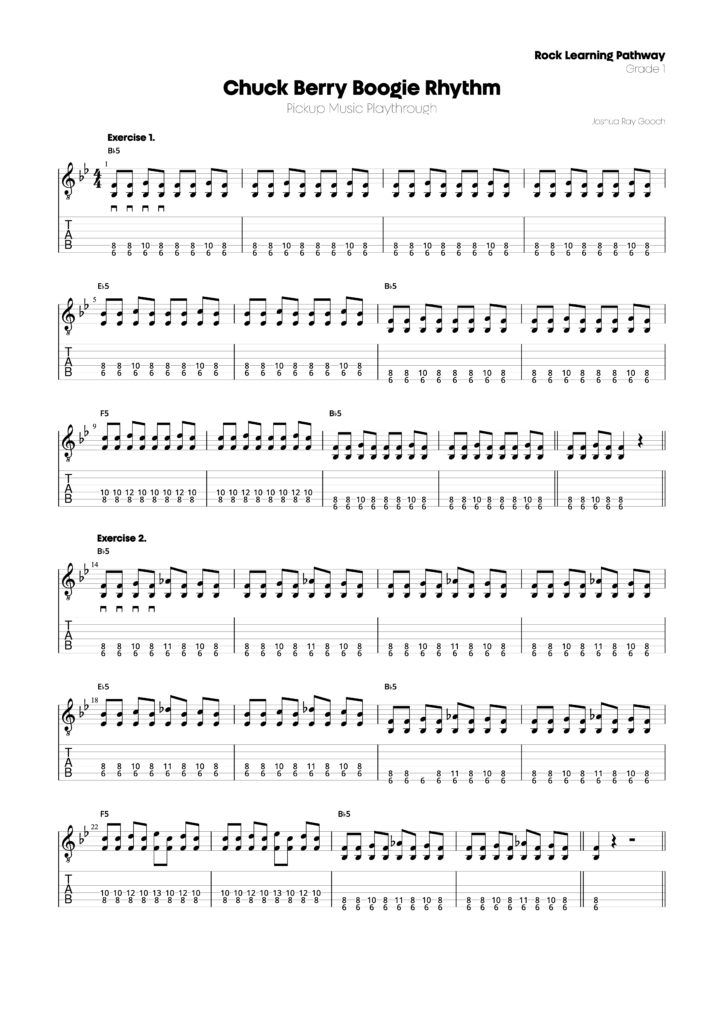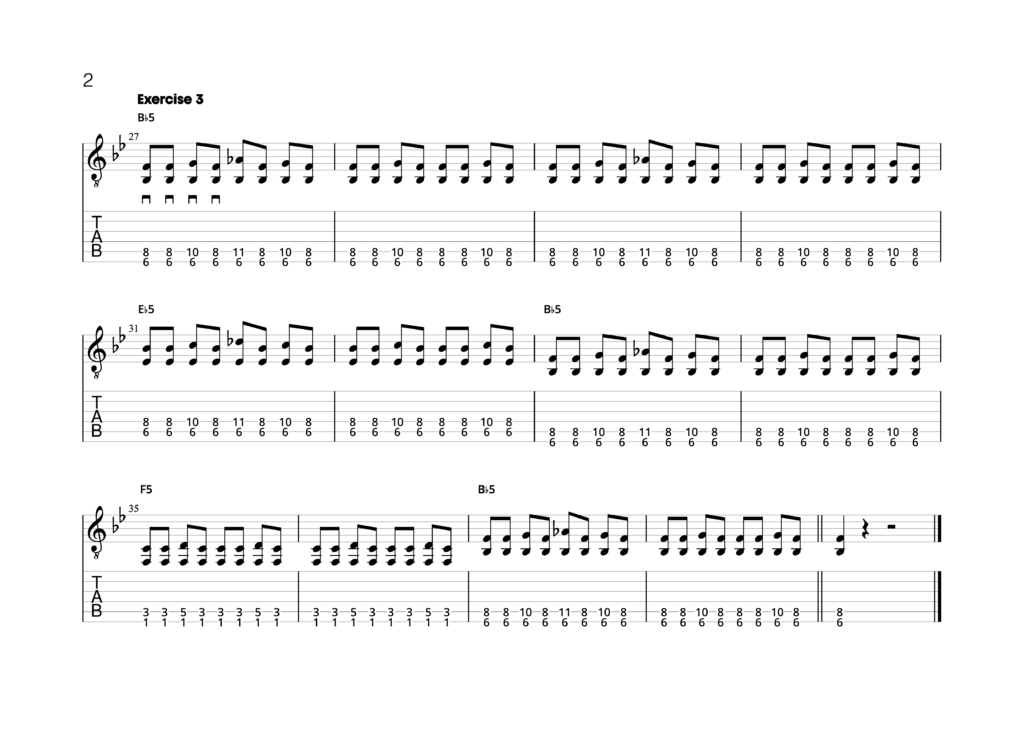
Chuck Berry Boogie Rhythm: Pickup Music Playthrough
- A brief history of rock ‘n’ roll
- Early roots
- Unique rhythm
- The birth of musical rebellion
- How to get the iconic Chuck Berry sound
- Tone
- Playing style
- Exercise 1: Basic Chuck Berry rhythm
- Positioning your fingers
- Moving between the I, IV, and V chords
- The ‘I’ chord – Bb
- The ‘IV’ chord – Eb
- The ‘V’ chord – F
- Exercise 2: Adding the flat seven
- Finger positioning
- Exercise 3: Mix it all up
- Melodic variations
- Different chord positions
- Time to jam!
- Want More?
- chuck-berry-boogie-rhythm-1.gp
Joshua Ray Gooch is here to educate you on some classic rock ‘n’ roll riffs!
In today’s lesson, we’ll dive into the legendary rhythm style of Chuck Berry. Make no mistake, rock ‘n’ roll guitar wouldn’t be what it is today without him, so let’s pay homage.
By the end of this article, you’ll know the background and context of this style, and how to play perhaps the most core rock ‘n’ roll riff there is.
So stick around… it’s gonna B. Goode.
A brief history of rock ‘n’ roll
Class is in session! We’ll get to the riffs in just a moment, but first, some valuable insight into this genre’s DNA.
Early roots
Rock and roll’s roots can be traced back to the 1940s and early 1950s, with pioneers like Fats Domino, and Bill Haley & His Comets laying the groundwork with their Rockabilly sound.
But what we consider true rock ‘n’ roll didn’t start until the mid-1950s. Artists like Chuck Berry, Little Richard, Elvis Presley, and Jerry Lee Lewis were revolutionizing the genre.
Unique rhythm
One of the key elements of early rock ‘n’ roll is its rhythm. Steve Jordan, the renowned drummer, explains that early rock and roll drummers were originally jazz musicians who played swing, shuffle, and big band styles.
The unique “rock ‘n’ roll sound” emerged from the combination of these shuffle rhythms with the straight eighth notes played by guitarists and pianists like Chuck Berry and Little Richard.
The “rock” is the straight 8th notes, and the “roll” is the triplet shuffle underneath. This juxtaposition of rhythms is what creates that distinctive feel.
The birth of musical rebellion
For some of you, 1950s rock ‘n’ roll is your grandpa’s music. But it’s important to bear in mind that this style was extremely controversial at the time.
The music was energetic, rebellious, and targeted at the youth, earning the label of “the devil’s music.”
When you listen to old rock ‘n’ roll records, try to appreciate it in context. It was basically the punk rock of its time – and most of society was horrified by it.
If that’s not rock ‘n’ roll, I don’t know what is.
How to get the iconic Chuck Berry sound
It takes more than some vintage gear to be Chuck Berry, but it certainly doesn’t hurt.
Tone
These are the steps for an ideal setup, but if you don’t have all (or any) of the gear, don’t sweat it – only the fourth one matters!
- A semi-hollow body guitar like the Gibson ES-335 with humbucker pickups for a rich, warm sound.
- A tube amp at high volume with moderate bass, elevated midrange, and moderate treble.
- A touch of light overdrive for slight grit and sustain.
- Keep effects minimal and play with energy and enthusiasm.
Playing style
You’re not going to master Chuck Berry’s guitar-playing style in ten minutes, but you’re about to get the ball rolling in the right direction.
One thing to note: play with down strokes as much as possible, it just gives it a more aggressive sound. Even today downpicking is the choice for most punk and heavy metal guitarists – thanks Chuck!
Okay, let’s learn a few fundamental rock ‘n’ roll exercises.
Exercise 1: Basic Chuck Berry rhythm
What’s the first ingredient in our rock ‘n’ roll guitar lesson? Blues!
Everything stems from somewhere, and a lot of blues guitar ideas crossover into early rock ‘n’ roll. We’ll start with a simple 12-bar blues progression in B-flat.
Some of you may already be familiar with this type of riff but play along anyway to get into the swing of things.

Download the Guitar Pro 8 file at the top of the page.
Positioning your fingers
- Place your index finger on the 6th fret of the low E string – this is our root note (B-flat aka Bb).
- Your middle finger goes on the 8th fret of the A string.
- Use your pinky to toggle on and off on the 10th fret of the A string.
The strumming pattern is straight 8th notes. Play all downstrokes, with no muting.
Strum twice without the pinky pressed down, then twice with the pinky – rinse and repeat!
Moving between the I, IV, and V chords
So what do these Roman numerals mean?
The number system is a great way to communicate a chord progression. First, it’s more simple than naming each note. Second, you can transfer the progression to any key instantly!
For example, if we’re in the key of C, it looks like this:
- C – D – E – F – G – A – B
- I – II – III – IV – V – VI – VII
Each number matches a note in the scale, so to play a I – IV – V in the key of C, the chords are C – F – G.
We’ll play this riff in the key of Bb, which looks like this:
- Bb – C – D – Eb – F – G – A
- I – II – III – IV – V – VI – VII
So the I chord is B, the IV chord is Eb, and the V chord is F.
Easy peasy!
The ‘I’ chord – Bb
You’ve already learned how to play the riff with a Bb root note, so let’s move on to the IV chord.
The ‘IV’ chord – Eb
Move the same shape across one string set so your index finger is on the 6th fret of the A string – now your root note is Eb.
Exactly the same shape and strumming pattern. Now for the V chord.
The ‘V’ chord – F
Okay, this is where things get really complicated. Slide the whole thing up two frets.
Done.
Congratulations, you just learned a I – IV – V rock ‘n’ roll progression in the key of Bb!
Exercise 2: Adding the flat seven
In this exercise, we add the flat seven to our previous riff. It gives us a little extra flavor and some more variation to play with.
This is quite a finger stretch so if you’re not already limbered up, run through these warmups.
Finger positioning
Everything remains pretty much the same. The position and basic riff pattern don’t change all you need to do is slide your pinky finger one more fret to hit that flat seven.
Got it? Okay, let’s play through the whole riff.

Download the Guitar Pro 8 file at the top of the page.
Exercise 3: Mix it all up
Although the basic chord progression may be simple enough, there are a ton of ways to keep it interesting.
Here are a few different ideas to keep you rolling.
Melodic variations
Play the fifth, sixth, and flat seven notes in various rhythms – they can go in any order. As long as you play that straight 8th-note rhythm, it’ll sound great.
Which notes you accent makes a big difference too. Emphasize some beats more than others and it’ll massively change the feel of the riff.
Different chord positions
You don’t need to stick to one area of the neck – try different positions. Wherever you find the root note chord is a potential home for the riff.
For example, our key is Bb and our I, IV, and V chords are Bb Eb, and F. Where else could we play the V chord (F)?
We have an F on the 1st fret of the low E string, right? So slide the whole shape down there to beef things up!
- Keep this in mind when you’re playing in different keys.
- Try to keep these types of rock ‘n’ roll riffs in a low register.
- The higher up the neck you take them, the weaker they sound.
One last thing to consider: The frets are further apart the lower you go on the neck, so some of those finger stretches could get a little tricky.
Try to find the sweet spot where it’s low enough to sound strong, without being uncomfortable to play.
Time to jam!
Now you’ve locked in all those exercises, it’s time to put them to work.
Play along with Joshua in the jam section of the video. Once you’re comfortable with that, check out some other rock ‘n’ roll backing tracks online.
Try to challenge yourself with different tempos and keys – have fun with it!
Want More?
This mini-lesson is part of the Rock Learning Pathway from Pickup Music.
It takes you through the decades of rock ‘n’ roll history so you gain a deeper understanding of this huge genre.
Right now you can get a 14-day free trial to all of Pickup’s content! There’s no better time to level up your guitar playing.
Leave a comment
Your email address will not be published.
| Title | Artist | |
|---|---|---|
| La Bamba | Los Lobos | |
Poison

|
Alice Cooper | |
Summertime Blues

|
Eddie Cochran | |
A Whiter Shade of Pale

|
Procol Harum | |
Dead Flowers

|
The Rolling Stones |

